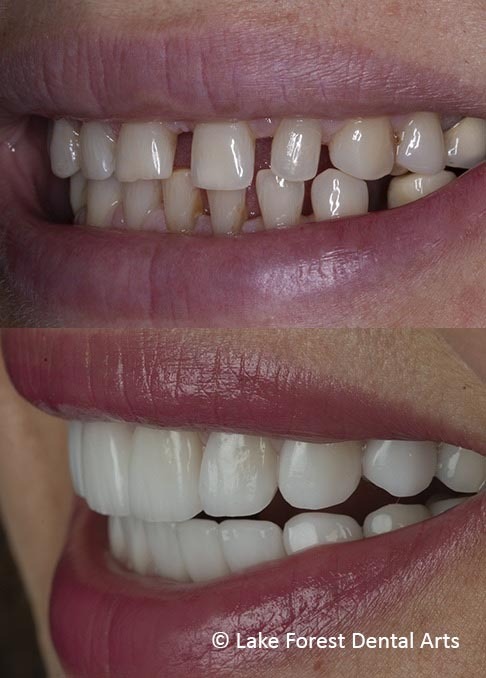
Do you have gaps in your smile or anywhere in your mouth? Some individuals embrace this trait. Others, however, may wish to fill spaces between the teeth for a more uniform appearance. Let’s discuss why extra space can occur between the teeth, and explains how to address the issue with cosmetic dentistry.
Why Do I Have Spaces between My Teeth?
A gap between two teeth is called a diastema. This condition is a variation of normal, and typically does not affect the state of your oral health. It is fairly easy to close the diastemas or to fill the spaces between the teeth. In addition to detracting from the appearance of a smile, a diastema can sometimes cause pain and discomfort – especially if your lips, cheeks, or tongue become caught in the space.
There are plenty of reasons why a space may occur. Some of the most common causes include:
- Oversized labial frenum
- Undersized teeth
- Receding gum line
- Lacking good oral hygiene or gum disease leading to jaw bone loss
- Difficulty swallowing
- Tongue thrust
- Missing teeth
- Thumb sucking
- Prolonged bottle or pacifier use

This patient had especially small teeth. The upper front teeth were so small that there were large spaces between them. She came to us wanting all of her teeth removed so that she could have a denture with normal sized teeth. To fill the gaps in her smile we made POM crowns with the shapes she requested.
Closing gaps in your smile
A variety of factors can lead to gaps between teeth. Often, misalignment or tooth protrusion cause gaps to form. In children, gaps between baby teeth are common, but usually close once their permanent teeth arrive. Other causes include tooth size discrepancies or even missing teeth.
Obviously, having braces is the best way of closing diastemas. Bonding, lifelike crowns, veneers, and tooth bridges all fill spaces between teeth. All of these options will be faster than doing braces.
Restoring the gaps in your smile
There are many cosmetic procedures that can close the gaps in your smile. Dental bonding allows the dentist to reshape the tooth using a special composite resin. Dr. Fondriest applies several thin layers of resin, then molds and sculpts the tooth as the material cures.
Composite veneers offer a strong and affordable means of closing gaps and repairing teeth. Dental bonding also erases permanent stains, giving patients brighter smiles.
Porcelain veneers are perfect for closing diastemas. Dr. Fondriest places thin shells of dental porcelain onto the patient’s front teeth. The opalescent veneers are custom made and shaded to blend seamlessly with a patient’s smile. In addition to instant whitening, veneers remove spaces and straighten misaligned teeth.
Porcelain veneers are stain resistant, and with proper care, can provide decades of durable and esthetically pleasing smile restoration. With cosmetic dentistry, Dr. Fondriest can give you a confident, and gap free, smile.
How to Fill Spaces between the Teeth
There are a few different options when it comes to closing down a tooth gap in your smile. The method recommended for you will depend on the size of the gaps between the front teeth. We will explore three common options in the sections below.
Cosmetic Dental Bonding
This bonding procedure involves applying tooth colored composite resin to the affected teeth. The resin is color-matched to your natural tooth so it will blend it with your smile.
To perform cosmetic dental bonding, Dr. Fondriest roughens the surface of the tooth to prepare it for bonding. Next, the composite resin is applied, shaped, and molded until the tooth is the desired shape and size. Finally, any last adjustments are made, and the teeth are polished to a high, natural looking shine. This is the least expensive treatment option.
Performing this on two consecutive teeth can effectively close down any spacing between them. If the gap is large, however, you may be better suited for alternative options.
Porcelain veneers and crowns can quickly fill spaces between teeth
Many patients wonder what are veneers. Veneers are strong, resilient, but very thin restorations that adhere to the front surfaces of the teeth. They are similar to dental crowns, but they do not cover the entire tooth structure. Crafted from medical grade porcelain, veneers can eliminate gaps in your smile and conceal other cosmetic imperfections as well.
Placing teeth veneers or crowns usually takes at least two dental visits. First, the affected teeth are prepared. To do this, Dr. Fondriest removes small amounts of enamel to create a better bonding surface for the restorations. Next, impressions are taken and sent to a dental lab.
There, a ceramist will create your new veneers or crowns according to your unique preferences and dental anatomy. They can be used to change shapes of teeth, align them, and brighten them. The prettiest ceramic types to use are feldspathic porcelain and Emax. The amount of change in your smile can be stunning.
Once the porcelain veneers are finished, they will be shipped to our office. We will schedule you for a second appointment, during which Dr. Fondriest will bond the restorations to your teeth. With proper care, veneers can last upwards of 20 years. See a recent veneer before and after case.
Orthodontics
Patients with severe or complex spacing may require orthodontics to correct the issue. Braces not only straighten the teeth, they also improve your overall oral health and function. If Dr. Fondriest determines that orthodontic treatment is needed, he will refer you to a trusted specialist in the area. Other issues such as periodontal disease may need treatment first.
Learn more about closing your diastemas
Interested in closing unsightly gaps between your teeth? If you have spaces between the teeth and would like the improve the appearance of your smile, schedule a consultation at our Chicago area boutique dental practice.
